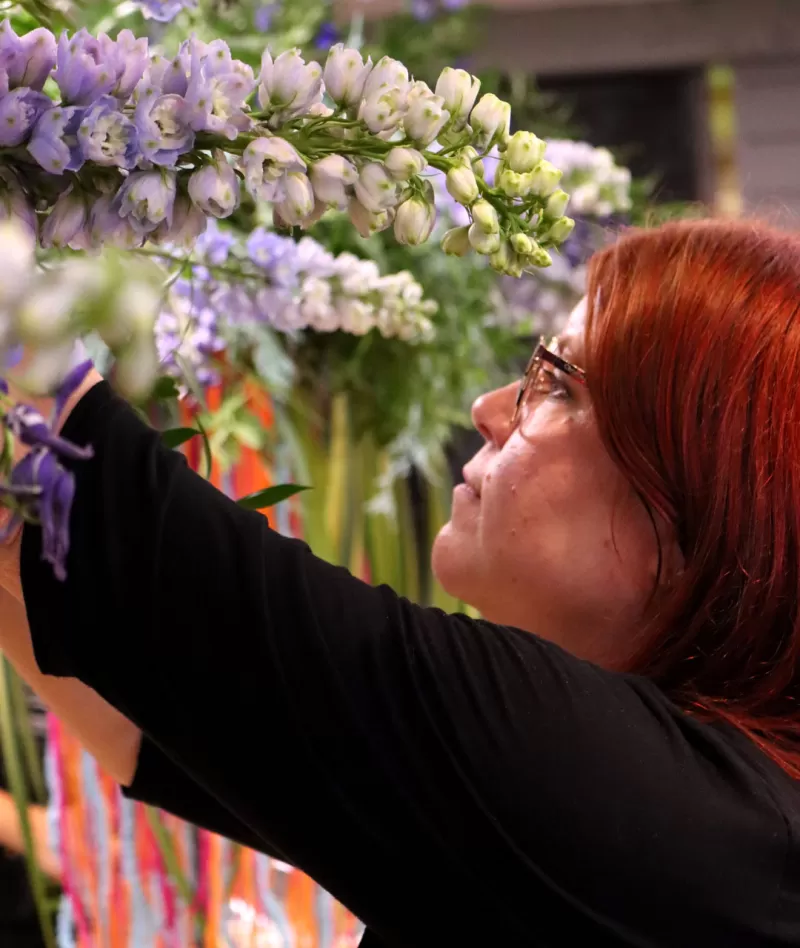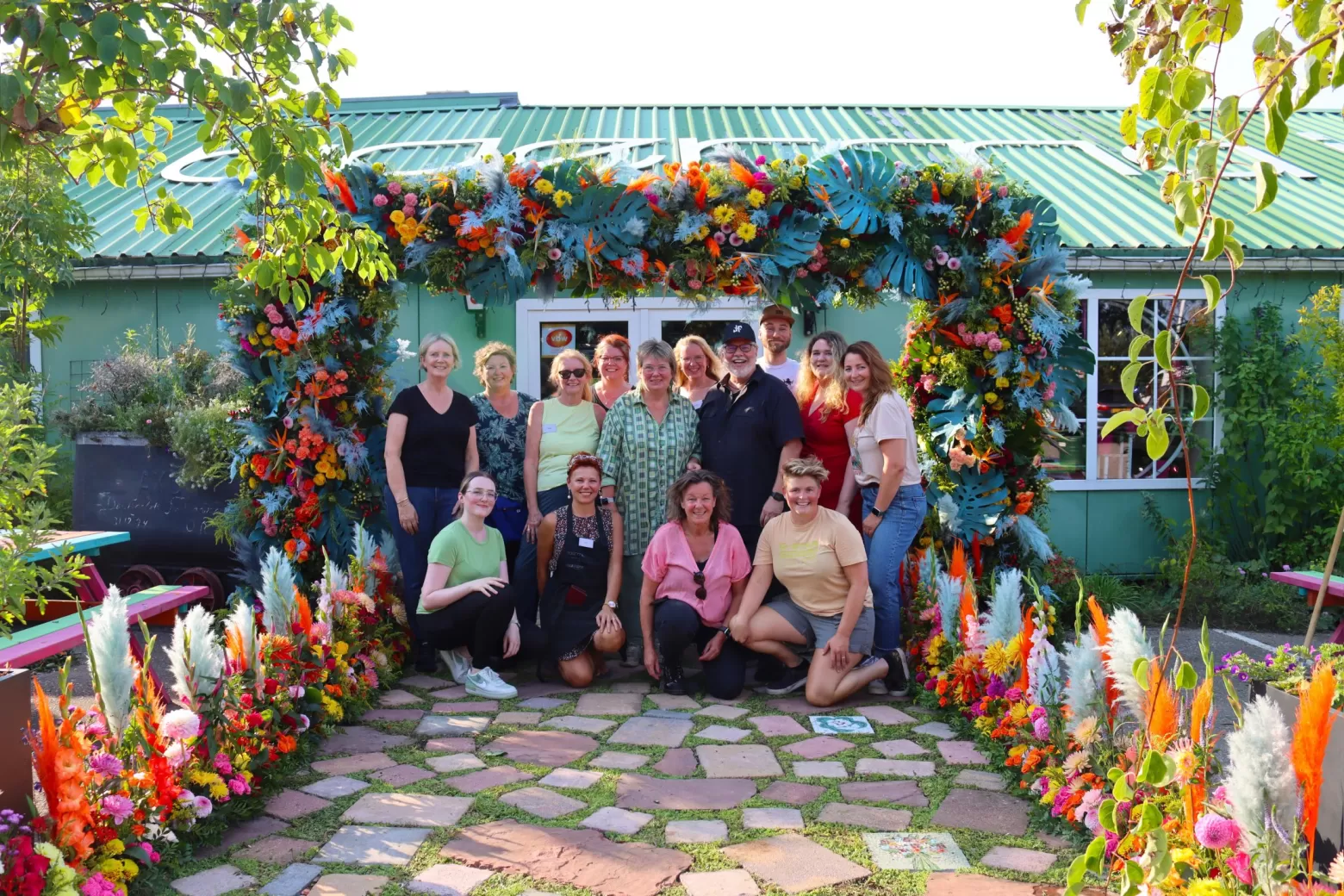
ometimes you meet people who can talk so passionately about their profession that, before you know it, an hour has flown by. That was exactly the case during this interview. We had the pleasure of speaking with the American duo Bill Schaffer and Kristine Kratt, experts in large-scale events and floral installations. They had just finished teaching a master course in Special Event Design at the Boerma Instituut. During this multi-day course, we were invited to sit in with the students, observe, listen, and be amazed. We wanted to learn more! Read on...
Introductions

Bill is not your typical designer. Alongside his expertise in floristry, he’s highly knowledgeable about the business side, able to precisely explain how to maintain healthy margins and where the pitfalls lie.
This Philadelphia-based designer is a third-generation florist but decided 25 years ago to look beyond his family’s flower shop. While the shop thrived, his heart was drawn to event design. Bill’s style is urban, architectural, and dimensional.
Kristine hails from the California Redwoods and works with an eye for detail. While Bill excels at sketching and calculations, Kristine’s strengths lie in crafting, creating, and embracing the organic aspects of design. She learned the trade at 16, started in flower shops, and later specialised in event design. She met Bill at an AIFD convention.
Together, and sometimes separately, they travel the world to create grand installations, run large floral shows, forecast trends, and design hardware.

Power couple
While Bill monitors trends for flower growers, Kristine focuses on trend watching for developing items such as vases. Their combined expertise is vast, and they complement each other perfectly. This also means they often travel independently. Kristine notes, “When we do meet, we always have plenty of stories to share.” As a couple, they shared their knowledge with a group of students at the Boerma Instituut. For example, what do you do if the floral arch you ordered turns out to be a metre taller than expected, and you don’t have enough flowers to fill it?
”You need to think fast and keep adapting.
Creative florists as successful entrepreneurs
Bill: “We’re not teaching florists to be better designers but to be successful entrepreneurs. We all need to make a living, but in a creative environment, people often forget that it’s still business.”
Not just floral design
From the outset, Kristine and Bill made it clear: over the coming days, the focus would be on how florists should work at events. Floral arrangements would be created, and techniques shared, but the main focus was on everything surrounding the design process. And by “everything,” they meant it: team management, logistics, delivery, and time management.

Photo credits: Mike Boerma
Teamwork & respect
“As a designer, you need to be able to put aside your personal taste and vision. This work is about your client, not you. When hired for a project, you’re collaborating with event planners and freelancers. Your task is to ensure all elements come together.” Communication is key to achieving this. But how do you go about it? Bill explains, “It’s all about teamwork. And always remain respectful.”
Time management
The more efficient your team is, the better. Overtime is costly, especially in the US. Bill’s first tip: ensure enough hands on deck. For example, assistants or inexpensive help can manage flowers, preparing them in water, while higher-paid designers focus on creating the pre-planned designs. Bill adds, “These days, I hardly touch a flower. I focus on the concept and design, and I fetch coffee for the designers who handle the floral work.”


Logistics
Bill and Kristine shared logistical anecdotes that seemed unbelievable but were true. Over the years, they’ve faced nearly every logistical challenge imaginable. From hundreds of speciality flowers that never arrived to refrigerated trucks that cooled a bit too well, resulting in frozen flowers. Or arriving at a venue with 56-kilo floral arrangements that needed placing in the centre of tables already set with linen and glassware. What do you do?
Proper preparation is crucial
Kristine suggests, “Bring rolling scaffolding that designers can stand on and move across tables. For hanging designs, use scissor lifts. Be mindful that these lifts need to go up and down repeatedly, which adds time.” They maintain strong relationships with their suppliers as well. “Recently, extra flowers were delivered last minute, straight from the airport to the event venue.”

How many flowers do you need?
A key question: how many flowers do you need? Bill displayed a colourful Excel sheet with his “recipe” for the design they’d be creating later that day. He stressed that florists need to think creatively. Instead of foliage, a stem of Solidago can be cut into three sections and used. The same goes for Delphinium—long stems don’t always have to be used as a single piece. Account for about 4% extra flowers to cover any breakage during transport.
Bill: “The recipes are critical. One or two stems across 500 arrangements can make the difference between profit and breaking even. If I want to be rehired, these recipes are essential. A good design needs to be repeatable, and if it’s not, you’ll have a gap to fill that shouldn’t be there. It’s the domino effect.” Kristine adds, “It’s not just experience; it’s planning. That’s the challenge. Florists are creative; they want to focus on creating. But it’s often the numerical side they find challenging.”
Learning from mistakes
Everyone makes mistakes, including Bill and Kristine. “Part of the magic is making it look effortless, but it takes years of experience. We make mistakes too, learn from them, and approach it differently next time.”
Never stop learning
Bill and Kristine highlighted the privilege of travelling and meeting florists worldwide. “The Boerma Institute proves that education is ongoing. If you think you’re done learning, either your ego is too big, or you’re out of touch with reality. The world constantly changes; you need to stay on top of developments.”

Kristine continued, “Sharing knowledge and learning from one another is crucial. Many florists are so busy they don’t take time to think about the journey from the farm to the vase. How many hands touch those flowers—over a hundred. It’s overwhelming to consider. It’s a massive industry that feels quite intimate.”
Boerma Instituut
Mike Boerma from the Boerma Instituut was thrilled to host the duo:
“Bill Schaffer and Kristine Kratt are two incredible designers. We met at a Floral Fundamentals photoshoot in 2018 and quickly became friends. Later, I worked with them at the Philadelphia Flower Show and on a major wedding in Texas (think 800 guests). They work together like a well-oiled machine. Their meticulous planning made the entire process incredibly smooth. I’ve worked on well-organised projects before, but this was something else.
That’s why I thought it would be amazing if they could teach a programme dedicated to their craft. Just as well organised as their event work, the class was flawless, with every detail thought through. The theory, tips, and tricks were fascinating, and it was wonderful to see students—who had never worked together or on such a large project—grow into a strong team. We’re now working on ways to bring them back next year!”
Interested in continuing your learning? See which other courses Boerma Instituut offers:



